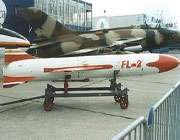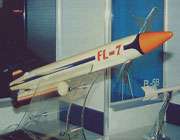آشنایی با موشک دریاپایه فی لانگ
در راستای توسعه و پیشرفت دو موشک ضد کشتی C-101 و C-301 که از نظر ابعاد بسیار بزرگ بودند چینی ها سری موشک های فی لانگ را معرفی کردند.
در دهه 50 روسیه تعدادی موشک پی15 با نام ناتوی استیکس را به چین واگذار نمود. چین از روی استیکس موشکی را با نام چینی "های ینگ" طراحی کرد. این موشک اساس و اصول اولیه موشک هایی را تشکیل دادند که چین از دهه 1960 الی 1985 روی آن فعالیت داشت. موشک های ینگ-1 با نام ناتوی CSSN-1 اولین نمونه از این نوع می باشد که ضد کشتی و دفاع ساحلی با قابلیت پرتاب از واحدهای شناور است.
نوع دوم آن، های ینگ2 است که ساخت آن در سال 1970 در چین شروع شد و مشابه پی-21 روسیه بود و علامت ناتوی آن CSSN-2 است که در غرب به کرم ابریشم نیز معروف است.
توسعه ی سری "فی لانگ" که از سال 1970 شروع گردید، بر مبنای موشک های ینگ-2 چین و پی-21 روسیه بود و تنها از نظر جثه کوچکتر از آنها است. این موشک موجب حیرت غربیها شد، بعدها در مدلهای دیگر نظیر فی لانگ-2 در سال 1986 و فی لانگ-7 در سال 1988 تولید گردید.
مشخصات عمومی
این موشک ها از نوع سطح به سطح با برد کوتاه، سرجنگی منفرد، پیشران سوخت جامد یا مایع و قابل پرتاب از واحدهای سطحی دریایی هستند. شکل عمومی موشک FL-1 مشابه HY-2 است با دو بال به شکل دلتا و سکان سه گانه است که در بخش ابتدایی بدنه قرار گرفته است.
این موشک ها از نوع سطح به سطح با برد کوتاه، سرجنگی منفرد، پیشران سوخت جامد یا مایع و قابل پرتاب از واحدهای سطحی دریایی هستند
مشخصات موشک فی لانگ 1
*طول:6.42 متر
*قطر:76 سانتی متر
*جرم با موتور کمکی: 200 کیلوگرم
*جرم بدون موتور:1740 کیلوگرم
*سرجنگی:51.3 کیلوگرم
سیستم هدایت موشک به صورت خلبان خودکار در فاز میانی و با رادار فعال تک پالسی در فاز نهایی است. ارتفاع یاب موشک از نوع رادیویی است که عمل سنجش ارتفاع موشک را در طول فاز میانی(30 متری سطح آب ) و در فاز نهایی و هجومی (8 متری سطح آب) انجام می دهد. موشک دارای دو موتور کمکی است که در بخش تحتانی بدنه آن قرار گرفته است که پرتاب اولیه موشک به وسیله آن انجام می شود. موتور اصلی فی لانگ 1 از نوع سوخت مایع بوده و این موتور برد موشک را به 40 کیلومتری می رساند.
مشخصات فی لانگ 2
*طول:6 متر
*قطر:54 سانتیمتر
*برد: 50 کیلومتر
فرق عمده دو نمونه فی لانگ1 و فی لانگ 2 در این است که سوخت موتور نوع دوم جامد است و علاوه بر آن، این مدل دارای پایدارساز، یا متعادل کننده افقی کوچکی است که در زیر سکانها و در بخش فوقانی عقبه قرار گرفته است. بقیه قسمت های هر دو نوع شبیه به هم هستند.
مشخصات موشک فی لانگ 7
*طول: 6.4 متر
*قطر:54 سانتیمتر
*جرم همراه با بوستر جداشونده:1800 کیلوگرم
*ماموریت:ضد کشتی و واحدهای شناور دریایی دشمن
*این سری متعادل کننده افقی ندارند و سوخت آنها نیز از جامد به مایع تبدیل شده است. هدایت موشک شبیه فی لانگ1 می باشد.
*برد موشک فی لانگ7: 30 کیلومتر
*وزن سر جنگی : 365 کیلومتر
*سرعت :2.4 ماخ
اعتقاد بر این است که این مدل از مقرهای مخصوص قابل پرتاب است و کنترل آن مشابه فی لانگ 1و 2 است. از کیفیت عملیاتی سری فی لانگ-7 اطلاعی در دست نیست. بجز اینکه مدل فی لانگ-1 در سال 1980 وارد خدمت در نیروی دریایی چین شد و به وسیله شرکت "CPMIC" ساختخ شده است. مدل فی لانگ-2 در سال 1983 وارد خدمت شد و احتمالا علت عدم موفقیت آن مربوط به پیشران سوخت جامد آن باشد. مدل فی لانگ-7 که در سال 1992 وارد خدمت شد هنوز هم در حال تکامل و توسعه است. مدل های فی لانگ 1و 2 به بنگلادش، پاکستان، تایلند و مصر صادر شده است.
In addition to developing the C-101 and C-301 supersonic anti-ship missiles which are fairly large in size, China has developed FL-7 (FL: Fei Long, meaning Flying Dragon) supersonic anti-ship missile which can be carried on airplanes and warships. The Feilong-7 has an effective range of 32 kilometers and a speed of Mach 1.4. It has powerful anti-jamming capability and its supersonic flight makes terminal interception difficult. The warhead of the FL-7 can pierce solid armor and destroy large and medium-sized surface warships. This missile can be roughly considered as the supersonic counterpart of the subsonic C-704 anti-ship missile. The missile is powered by a liquid fuel rocket motor and a solid rocket booster, which is under the airframe at the rear.Along with C-101, FL-7 competed for the air-launched supersonic anti-ship missile program in China during the 1990’s. However, C-101 was selected because it flies at faster speed and its range is nearly a third greater than that of FL-7, while it only weighs slightly heavier. Being the last Chinese anti-ship missile with rocket motor powered by liquid fuel, the role of FL-7 is decreasing, but not yet immediately phased out. The reason is that the Chinese coastal defense doctrine when using anti-ship missiles: multi-direction, multi-altitude, multiple waves attacks on targets with both supersonic and subsonic anti-ship missiles to make it difficult for the targets to defend itself from such saturated attacks, FL-7 is thus still have a little role to play in such saturated attacks at shorter range. However, it is safe to conclude that as newer missiles becoming widely available, the role of FL-7 would continuously decrease to its eventual retirement.Western sources have claimed in 1996, with Chinese help in the forms of technology sales, that Iran had begun indigenous production of a medium-range anti-ship missile, based on the technologies of FL-7.Length: 6.59 mDiameter: 0.54 mWeight: 1,770 kgWingspan: 1.86 mWarhead: 360 kgSpeed: > Mach 1.4Range: 32 km max.Guidance: active radar homing seeker (Other types of seekers being developed)Propulsion: one liquid rocket engine with a solid rocket booster· China and Russia are the only two countries to have successfully developed supersonic anti-ship missiles, which represent the future direction of anti-ship weapons. The majority of anti-ship missiles are high subsonic. In addition to developing the C-101 and C-301 supersonic anti-ship missiles which are fairly large in size, China has developed the more compact Feilong (Flying Dragon)-7 supersonic anti-ship missile which can be carried on airplanes and warships. The Feilong-7 has an effective range of 32 kilometers and a speed of Mach 1.4. It has powerful anti-jamming capability and its supersonic flight makes terminal interception difficult. The warhead of the "Feilong-7" can pierce solid armor and destroy large and medium-sized surface warships.· It was reported in 1996 that Iran had begun indigenous production of a medium-range antiship missile, the FL-10, based on the Chinese FL-2 or FL7 and developed with Chinese technical assistance.The C-101 (FL-2) is a supersonic anti-ship missile that can be launched from air, ship, and shore. The missile is also known as Fei Long - 2 (meaning Flying Dragon – 2, or FL-2 for short), and there are two side-mounted ramjet engines at the rear of the airframe. The development of C-101 missile started in the late 1970s, and production began in the mid-1990s, as part of the replacement of the obsolete HY-2/CSS-N-2 missiles. The Chinese Navy tested the C-101 anti-ship missile on the Hoku-class missile boat, and Huang-class missile boat are being fitted with four C-101 launch tubes, while smaller classes carry two launch tubes. The air launched version has been reportedly carried on the H-5 and Xi’an H-6 bombers and the Harbin SH-5 amphibian and eventually expanded to most of the aircraft in the Chinese inventory. The armed with a 300 kg semi-armor-piercing warhead with a delayed impact fuse. Cruising at an altitude below 50 meters, the missile dives about 3 kilometers away from the target to 5 meters above the sea level and then dive to attack, impacting just above the waterline.Length: 5.8 meterWingspan: 1.2 meterWeight: 1,850 kgWarhead: 300 kgRange: 45 kmSpeed: > Mach 1.7 cruise, > Mach 2 in attackCruise altitude: < 50 meter in flight, 5 meter at final stagePropulsion: two ramjet enginesGuidance: active radar homing seeker (other types of seekers have been developed)C-101 anti-ship missile has lower speed and higher cruise altitude than the larger and more potent supersonic anti-ship missile such as SS-N-22, and thus is relatively prone to interception in comparison to SS-N-22, but this drawback is partially made up by its smaller radar cross section and lower infrared signature. The same advantages are retained when compared to the subsonic Silkworm missiles, which also have higher cruise altitude and lower speed in comparison to C-101. As a result, C-101 saw wider service in Chinese armed forces than its larger cousin C-301, mainly as a stopgap measure for the air force until the newer supersonic missile such as the Russian Kh-31 becomes widely available, and as an upgrade for older missile boats such as the Heku class to replace the original Silkworm missiles onboard. Although Chinese claim that other type of seekers such as infrared imaging and television seekers have been successfully developed, the status is rather uncertain due to the availablility of newer anti-ship missiles











 پاسخ با نقل قول
پاسخ با نقل قول

علاقه مندی ها (بوک مارک ها)